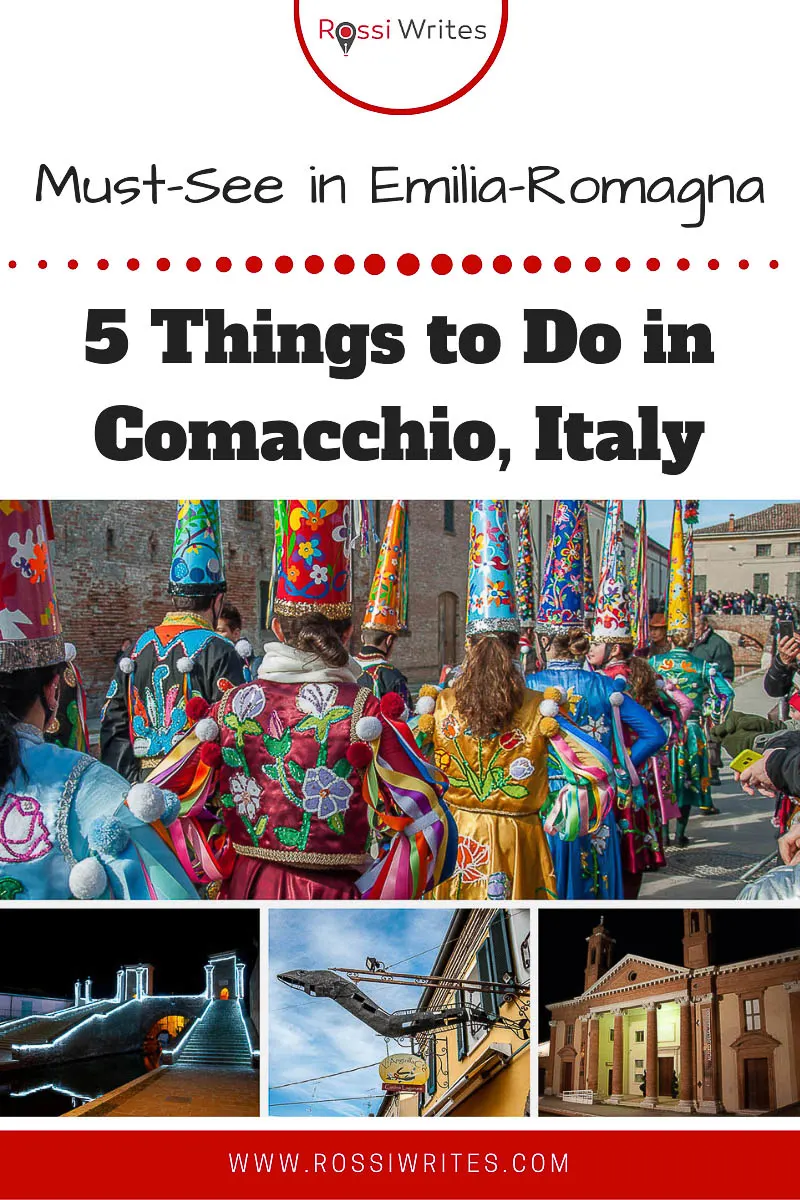Comacchio is an Italian town of pastel facades, rich archaeology, and fun Carnival traditions.
Built on 13 small islands connected by brick bridges, the town is often called the Little Venice.
Surrounded by the wetlands of the Delta of the River Po and a stone’s throw away from the Adriatic Sea, Comacchio has its own character though and a history that is rich with Etruscan, Roman, and medieval references. Little-known compared to Italy’s tourist magnets, this small town has many exciting experiences to offer to those who are not afraid to stray off the beaten track and to live Italy authentically.
A great day trip from the nearby towns of Ferrara and Ravenna, Comacchio is also easy to reach from larger Italian cities like Bologna and Padua.
So, if you are looking for a small and quirky destination in Northern Italy, a place where history and nature meet and people make good food, then Comacchio could be just the right fit.

You will find Comacchio in the Northern Italian region of Emilia-Romagna. The town is on the edge of its own lagoon that carries the same name – Comacchio. The remains of an ancient Etruscan city lie nearby and a wrecked Roman merchant ship was excavated in the vicinity a few decades ago. The town’s archaeology museum tells their captivating stories.
With a history that spans two millennia, Comacchio preserves many historic buildings and structures. From a 17th-century fortified bridge that protected the town when it could only be accessed by water to a 400 m long arcade with 143 arches, Comacchio has several must-see landmarks. The most famous thing here though are the local eels which are roasted and marinated following a centuries-old process.
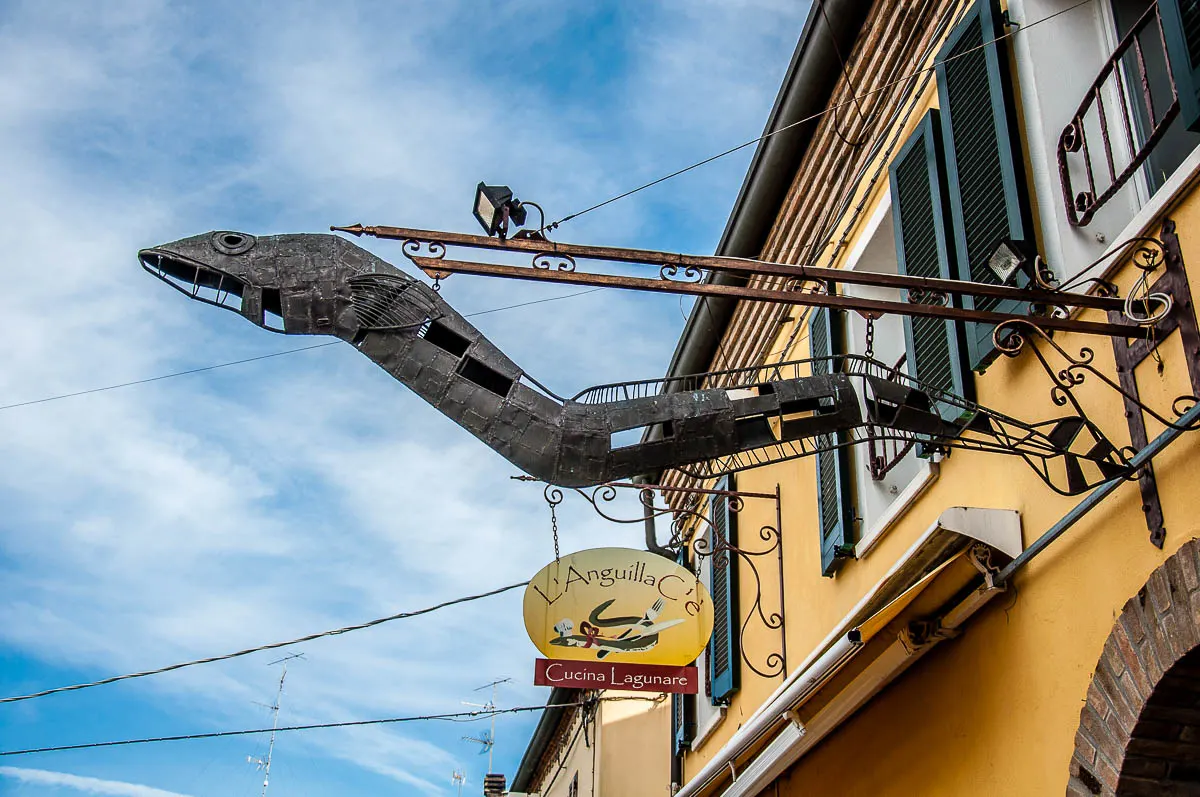
I had the chance to spend a lovely February weekend in Comacchio, Italy during the town’s exuberant Carnival celebrations. Their highlight is a parade of Carnival boats down Comacchio’s navigable canals.
It was great! People in folk costumes danced, boats disguised as a mouse and a beehive (among other things) floated past me, everyone threw confetti and the day felt so full of light and happiness.
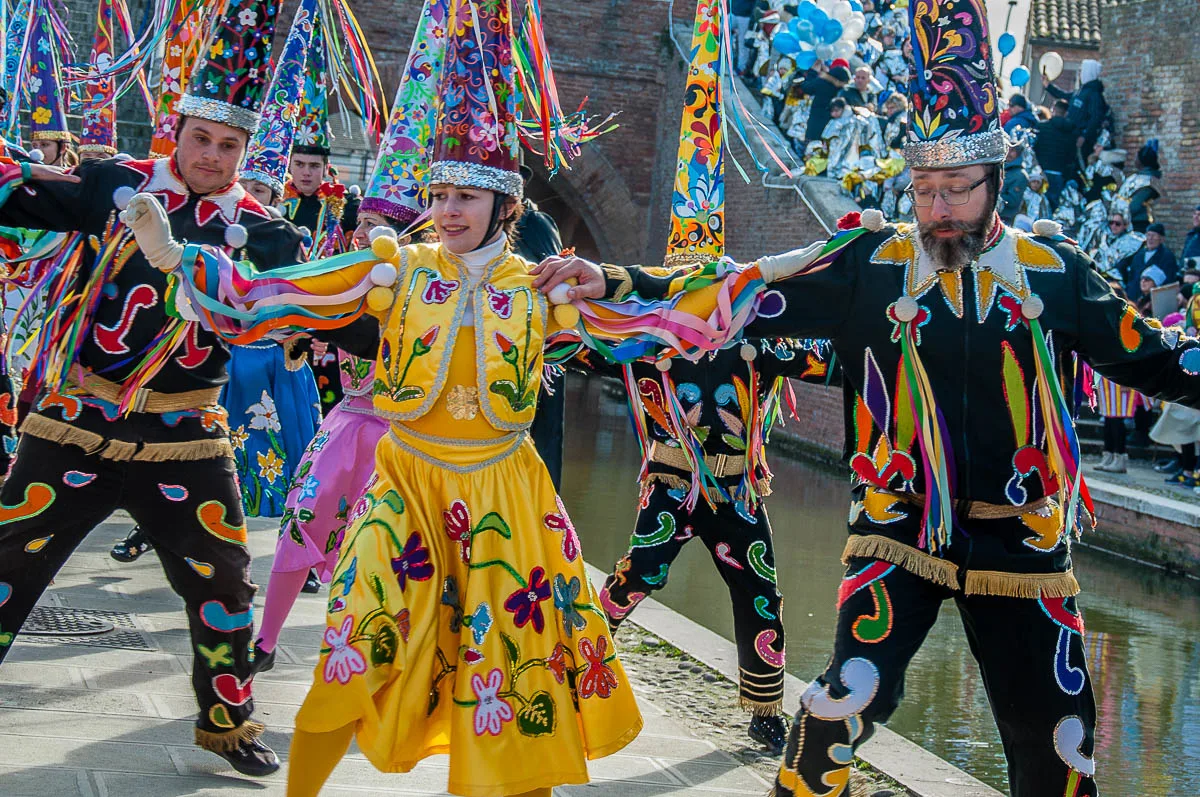
In addition, I visited Comacchio’s outstanding archaeology museum and its old fish marinating factory. And I walked all over this pretty Italian town at night when it was all so quiet…
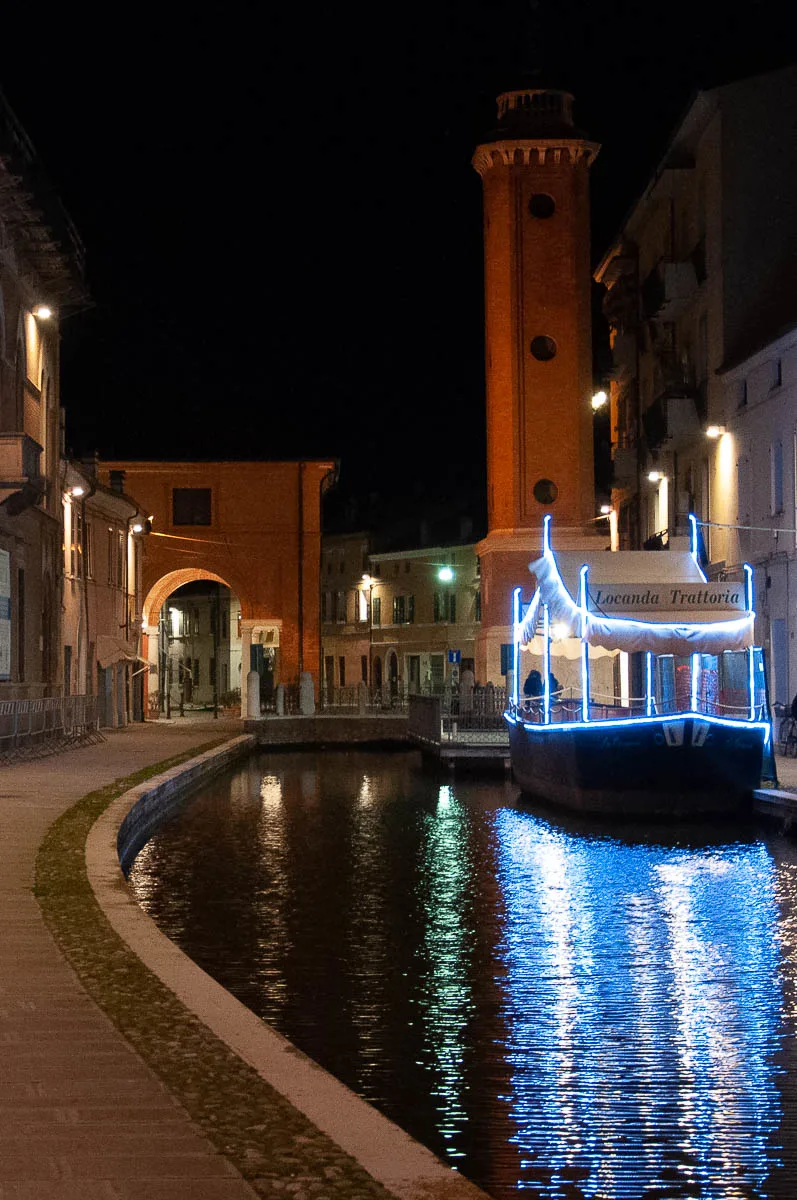
and during the day when crowds of people flocked to have Carnival fun.
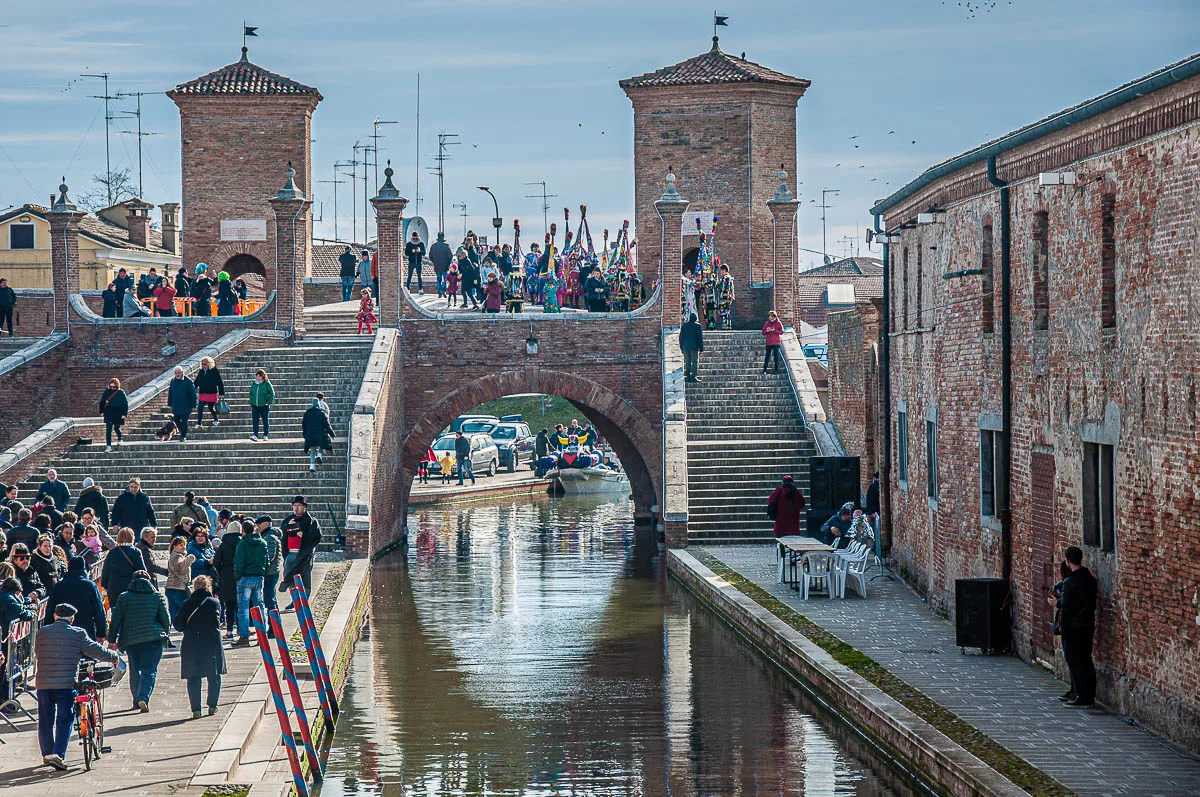
So, today, I want to share with you all the exciting things I saw and learned in Comacchio. I hope that the information provided herewith will spark your curiosity and that this pocket-size Northern Italian town will soon feature on your must-see in Italy list.
Now, let’s start!
Comacchio, Italy – 5 Things to Do in the Town of Archaeology, Eels, and Carnival
1. Museo Delta Antico (Ancient Delta Museum)
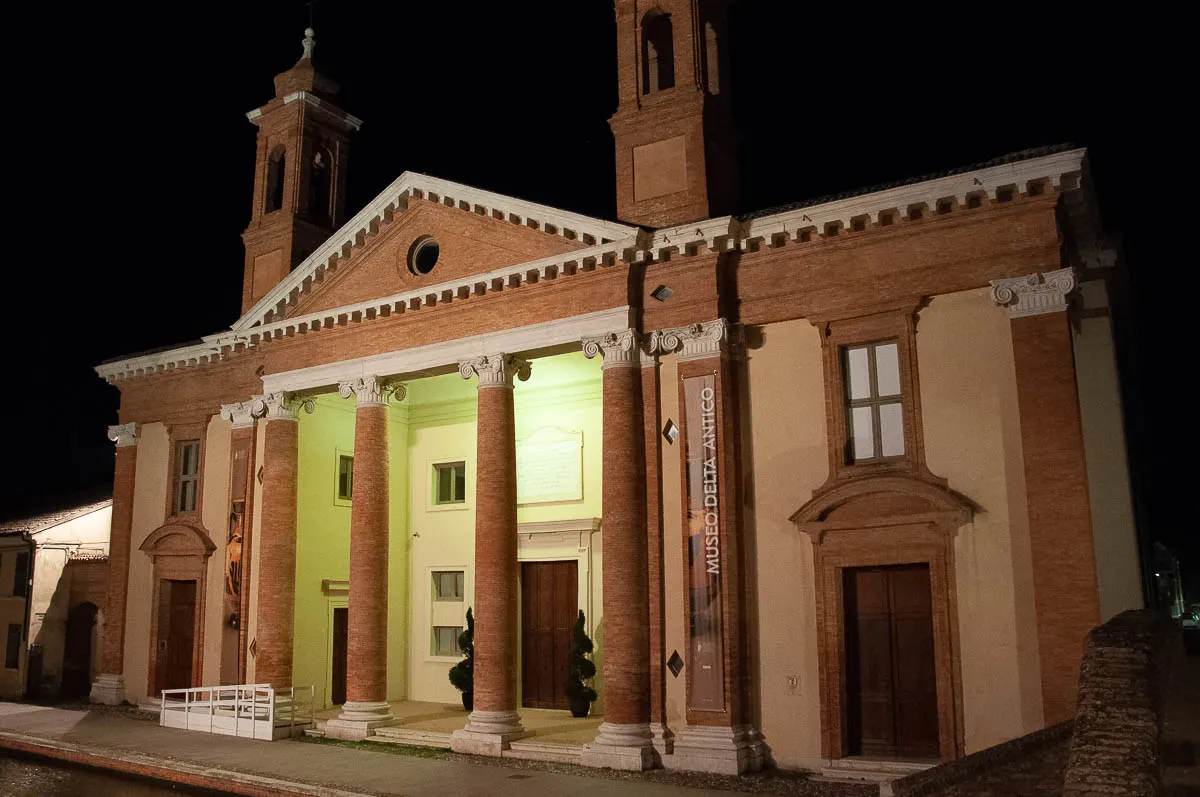
The most striking building in Comacchio houses one of the most exceptional archaeology museums I have had a chance to visit. It was built in the second half of the 18th century of white Istrian stone and the typical for the towns and cities of Emilia-Romagna red bricks. Designed in the neoclassical style, it looks like an ancient temple.
The building originally functioned as a hospital. Standing on the edge of a canal in the town’s historic centre, Comacchio’s Ospedale degli Infermi (Hospital for the Infirm) only closed its doors at the end of the 1970’s.
It was then converted into the Museo Delta Antico (known in English as the Ancient Delta Museum). It houses Comacchio’s rich collection of over 2,000 archaeology artefacts tracing the development of this corner of Italy from the prehistory to the Middle Ages. The focus is on the Delta of Po – the longest river in Italy. The delta is a rich natural area crisscrossed by navigable canals and wetlands. Comacchio is one of its major centres. In the past, a place adjacent to the modern-day town served as a busy meeting point between the Mediterranean civilisations and Continental Europe.
This is where in the 6th century BC, a thriving Etruscan port city called Spina was founded at the ancient mouth of the river Po. Spina was where the Amber Road, starting from the Baltic Sea, led to and where large quantities of Ancient Greek ceramics, wine, oil, and other imports arrived for further distribution to Northern Italy and Europe.
The necropolis of Spina – discovered at the start of the 20th century about four miles away from Comacchio – has over 4,000 tombs. A small number of them have been studied and the findings are presented in the Ancient Delta Museum.
The highlight of the museum though is the cargo of a Roman merchant ship. Discovered in the vicinity of Comacchio in 1981, the ship was called Fortuna Maris, it was 21 m long and five metres wide, and it was shipwrecked in the 1st century BC. In the Ancient Delta Museum you can see the full cargo of the ship – from the Greek amphorae and the Spanish lead ingots it carried to the personal possessions of the crew and passengers to the shell of the turtle that served as the ship’s talisman.
Finally, the museum also introduces you to the history of Comacchio – a town with many centuries of existence that changed hands multiple times during the Middle Ages. Goths, Byzantines, Lombards, Venetians fought over Comacchio – then a prosperous community that harvested salt from the nearby salt pans.
Between the 6th and the 9th centuries AD, Comacchio had a navy so powerful that in 810 AD Charlemagne used the town’s boats to attack the Republic of Venice. Venice – at the time also relying largely on salt harvesting for its riches – didn’t appreciate having Comacchio as a rival in the salt business. As such, Comacchio was attacked and conquered several times by Venice during the Middle Ages.
When in Comacchio, don’t miss a visit to its Ancient Delta Museum. Even if ancient and medieval history may not be your thing, the museum is very well organised and a pleasure to explore. Put at least an hour aside to be able to see it all, to read all the information provided, and to watch the videos in the different museum rooms.
Personally, I found the rooms with the cargo of the Roman merchant ship of utmost interest. I loved seeing the tiny temples that the ancient Romans would carry with them to pray to their deities and perform rituals on the spot.
Important Information:
Bear in mind that the Ancient Delta Museum’s opening hours differ according to the month and the season. Make sure that you check them in advance here in order to avoid disappointment. The museum also closes for the traditional Italian lunch break called riposo, so schedule your visit in the morning or later in the afternoon. On Mondays, the museum is closed except during the months of July and August.
2. Carnevale sull’Acqua
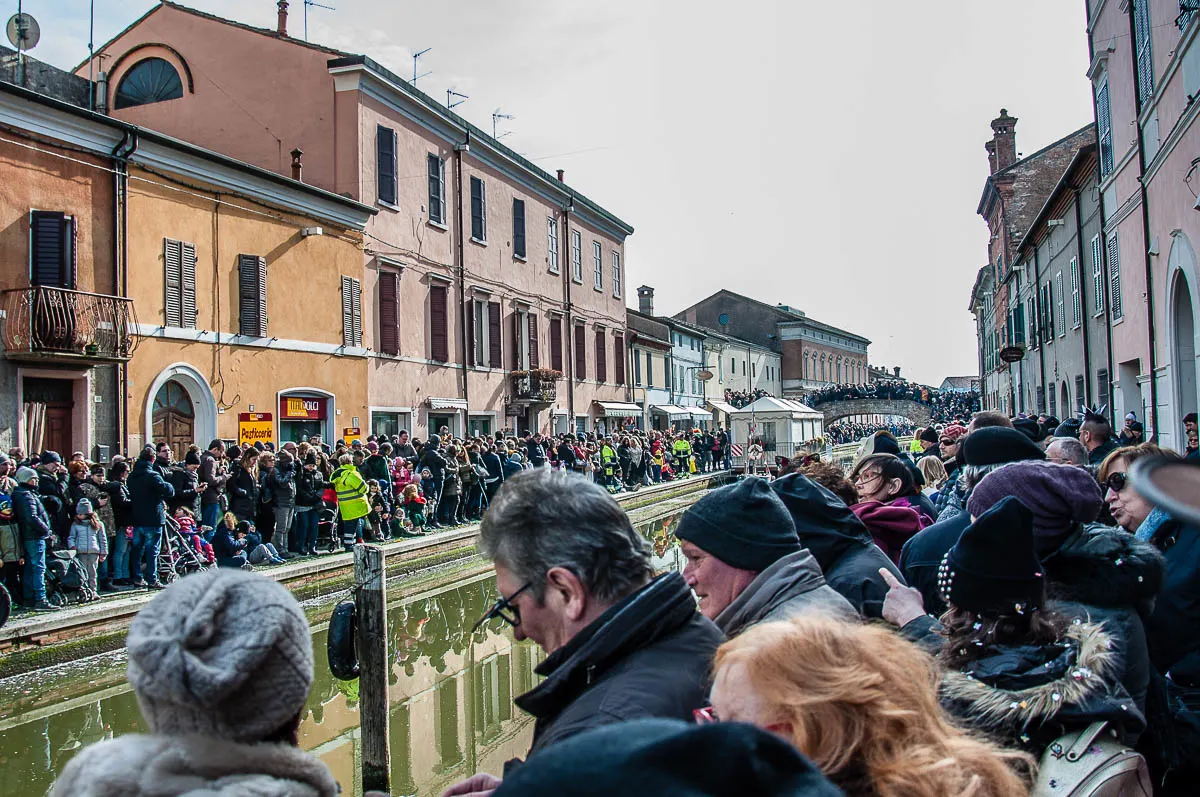
Each February Comacchio stages a splendid Carnival celebration with a twist. Called Carnevale sull’Acqua, its parade takes place on water instead of on firm ground. Typical for the area boats called batana are festively decorated and manned by masqueraded crews. Blasting music and confetti, they float down the town’s canals for the delight of the thousands of spectators.
It’s a great alternative to the crowded and touristy Carnival in Venice. In Comacchio, instead, you are surrounded by locals, many of them disguised in quirky costumes. The music pumps in the air, a large market sells traditional food and trinkets, and each Carnival boat has its own confetti cannon.
The first event of the day is the Kids’ Carnival with the children from the local schools and nurseries parading dressed in creative costumes accompanied by their parents and teachers. It is quite cute, really, as each school’s costumes follow a particular theme chosen by the students.
The main Carnival event is in the afternoon when the Carnival boat parade starts. The night before the Carnival we went for a little walk around Comacchio and saw the boats moored underneath the town’s most famous bridge – Ponte dei Trepponti. Already decorated, they were covered with plastic sheets to keep them dry and safe overnight.
The day after we saw them and their crews in the full swing of Carnival. Click here to see three videos I took during the parade. The videos are hosted on my blog’s Facebook page (if you haven’t already, could you, please, like it and follow it? Thank you so much!).
Comacchio’s Carnevale sull’Acqua is a relatively new experience, having been started in 2012. Yet, it has quickly gained widespread recognition and it was even broadcasted on Italian TV in 2019. Comacchio first held a Carnival on water back in the 1920’s. Old photos show large crowds of people watching the parades back then. An attempt to revive the celebration in the 1980’s only lasted for two years. Nowadays, Comacchio’s Carnival is going from strength to strength.
For maximum Carnival fun, be there about an hour or two before the start of the water parade. Find a place in the vicinity of the Trepponti Bridge as this is where the Carnival crews are presented to the public and this is also where the parade starts from. Another good place is near the Ancient Delta Museum. It is not as suffocatingly crowded as in Venice (yet!) but don’t turn up at the last minute as you will find all the good spots long gone.
Important Information:
Comacchio’s Carnevale sull’Acqua traditionally takes place over the two Sundays of Italy’s two-week-long Carnival period. Bear in mind that in case of adverse weather, the parades are moved to later dates, so check the weather forecast before making definite travel plans.
To fully get in the Carnival spirit, make sure that you wear a costume yourself.
Thousands of people flock each year to Comacchio’s Carnival. While finding a parking space just outside of the historic centre is not particularly difficult, it’s best to book your meals in advance if you are intending to lunch and dine in the best local restaurants. Otherwise, they may not be able to accommodate you at the last minute.
The Carnival has a strong family-friendly feel to it. Kids dress up in festive costumes and enjoy the Carnival parade, the street performances and the small fairground.
3. Historic Centre
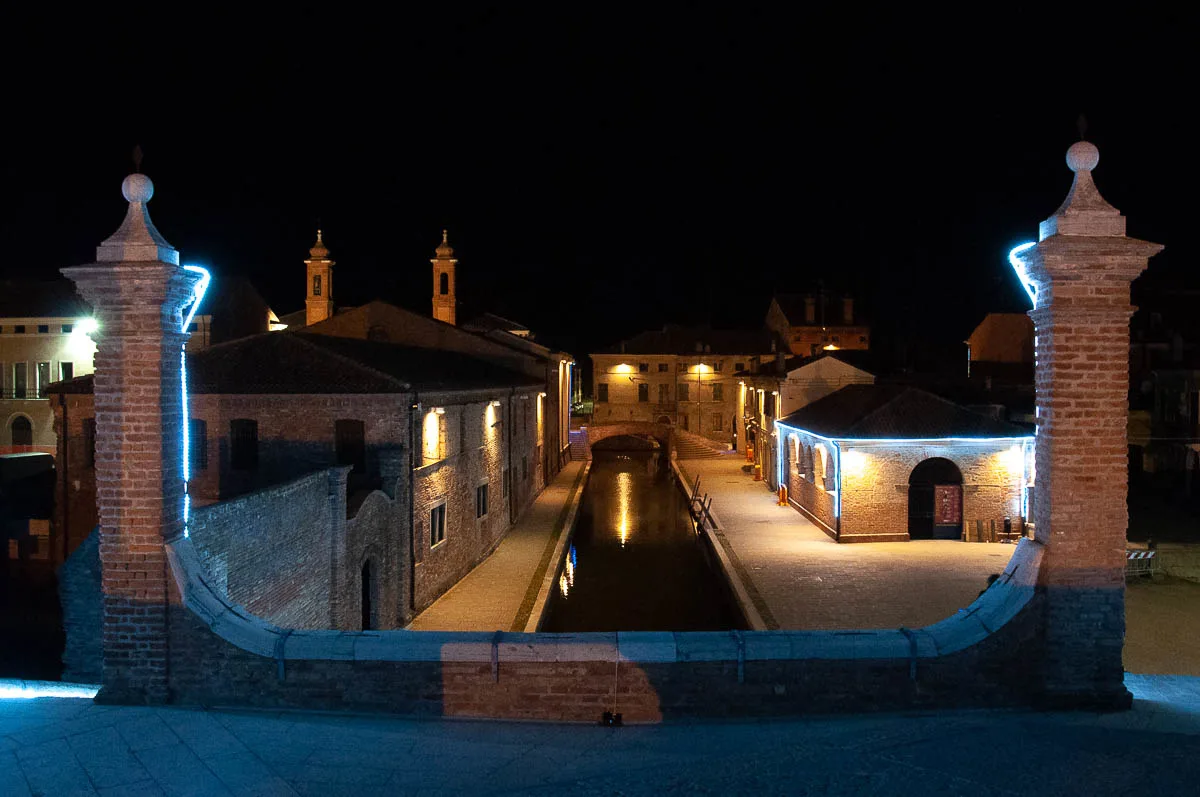
Built on 13 small islands crisscrossed by canals, Comacchio is a delight to explore on foot. This pocket-size town has everything to keep your attention for a couple of hours – interesting churches, some palaces, and above all, a number of elegant bridges.
While there are no lavish marble facades here, the red bricks and the pastel colours of the local buildings and houses give the town a lovely lived-in feel.
Here are some of the most important sights to see in Comacchio for yourself:
- Ponte dei Trepponti (also known as Ponte Pallotta) – Comacchio’s most defining feature. This large 17th-century bridge had a defensive purpose. It functioned like a fortified city gate when access to the town was only possible by water. The bridge has five rounded staircases and two towers. It connects the town’s canals with the canal that leads to the Adriatic sea.
- Ponte delle Carceri (also known as Ponte degli Sbirri) – the Prisons’ Bridge (or Cops’ Bridge) is right next to the town’s former prisons and on the way to the splendid Museo Delta Antico.
- Other bridges – crisscrossed by canals, the town of Comacchio has several bridges. Made of bricks, some of the most important ones are: Ponte di San Pietro, Ponte di Borgo, and Ponte dei Sisti.
- Canal Pallotta – lined by some of Comacchio’s most important buildings, this is an ancient water canal that leads to the Adriatic Sea. The canal carries the name of Cardinal Giovan Battista Pallotta who commissioned the Trepponti Bridge.
- Loggia dei Mercanti del Grano – built in 1621 of Istrian stones and red bricks, it was used as a grain storehouse. You will find it next to Comacchio’s clock tower and originally it flanked the Ponte di Piazza – a once splendid but no longer in existence bridge.
- Torre Civica (Clock Tower) – built in the 19th century to replace the original 14th-century tower. In the past, it also flanked the demolished Ponte di Piazza.
- Palazzo Bellini – an elegant 19th-century building where nowadays you will find the town’s library, an art gallery, and the historic archive.
- Comacchio Cathedral – the town’s cathedral has been standing at this place since at least 708AD. Its current imposing building was consecrated in 1740. The Cathedral is dedicated to St. Cassian of Imola – Comacchio’s patron.
- Bell Tower – originally built in 1751, Comacchio’s bell tower collapsed shortly afterwards in 1757. It was then re-built over a long period of time and eventually completed in 1868 on the base of the collapsed tower.
- Sanctuary of Santa Maria in Aula Regia – this 16th-century church with a 19th-century facade is on the spot where a 10th-century monastery once stood. A 400 m long arcade – the Loggiato dei Cappuccini – leads to the sanctuary. The arcade was built in 1647, then destroyed by an earthquake and erected again. It has 143 arches, each supported by a marble column.
- Other churches – as every Italian town, Comacchio is rich in places of Christian worship. Some of the most important churches here are: Church of the Rosario, Church of the Suffragio, Church of Carmine, and Church of Santi Mauro and Agostino.
4. Manifattura dei Marinati
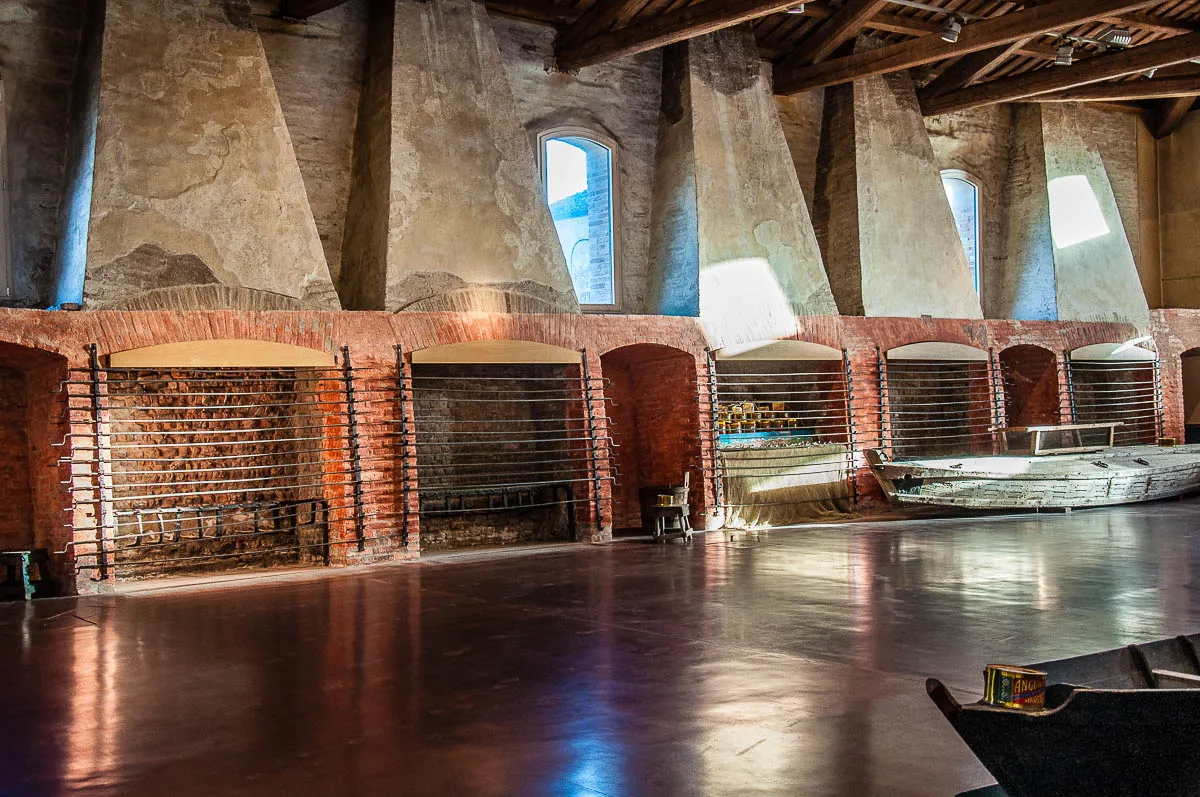
The fish marinating factory Manifattura dei Marinati is a jewel of Italy’s’ industrial architecture. Don’t miss it! Visiting it opens the doors to the old and esteemed culinary art of eel roasting and marinating.
Eels are especially plentiful in the waters surrounding Comacchio. They have been a staple in the diet of the locals for centuries. A complex process was developed here over many years – from the capture of the eels at their fatest to their transport to the factory and subsequent preparation for consumption. In decades past, the whole economy of Comacchio was based on the production of eel food products.
So famous are Comacchio’s eels all over Italy that a film with Sophia Loren was filmed here in 1955. Called La Donna del Fiume (River Girl), in it, you can see the star of the Italian cinema working in Comacchio’s Manifattura dei Marinati.
Iconic scenes from the film are shown during your visit to the old fish marinating factory. Large posters of Sophia Loren adorn the walls. Yet, the main character here are the eels of Comacchio. Walking from room to room, you learn about the history of eel marinating, admire the huge fireplaces in which the eels are roasted, and marvel at the complex system of eel-fishing basins and the many different tools used for the catching and preparation of eels.
The Manifattura dei Marinati nowadays functions both as a museum and a factory:
- Ecomuseum of the Valli and the Fish Marinating Factory – come here to learn about eel marinating in Comacchio and the wetlands – Valli di Comacchio – where the eels are caught each autumn;
- Marinati di Comacchio – each autumn the Manifattura dei Marinati once again becomes a factory where eels and fish are roasted and marinated in salt and vinegar following a process first used in the 17th century. You can buy the products of the Marinati di Comacchio brand all over town and in Italy’s best delis. Particularly famous are the tins with marinated eels and anchovies.
You will find the entrance of the Manifattura dei Marinati towards the end of the 400 m long arcade leading to the Sanctuary of Santa Maria in Aula Regia. It’s a nice walk away from Comacchio’s centre. On foot, it will take you about ten minutes to walk there from the Ancient Delta Museum.
5. Eels and Local Food
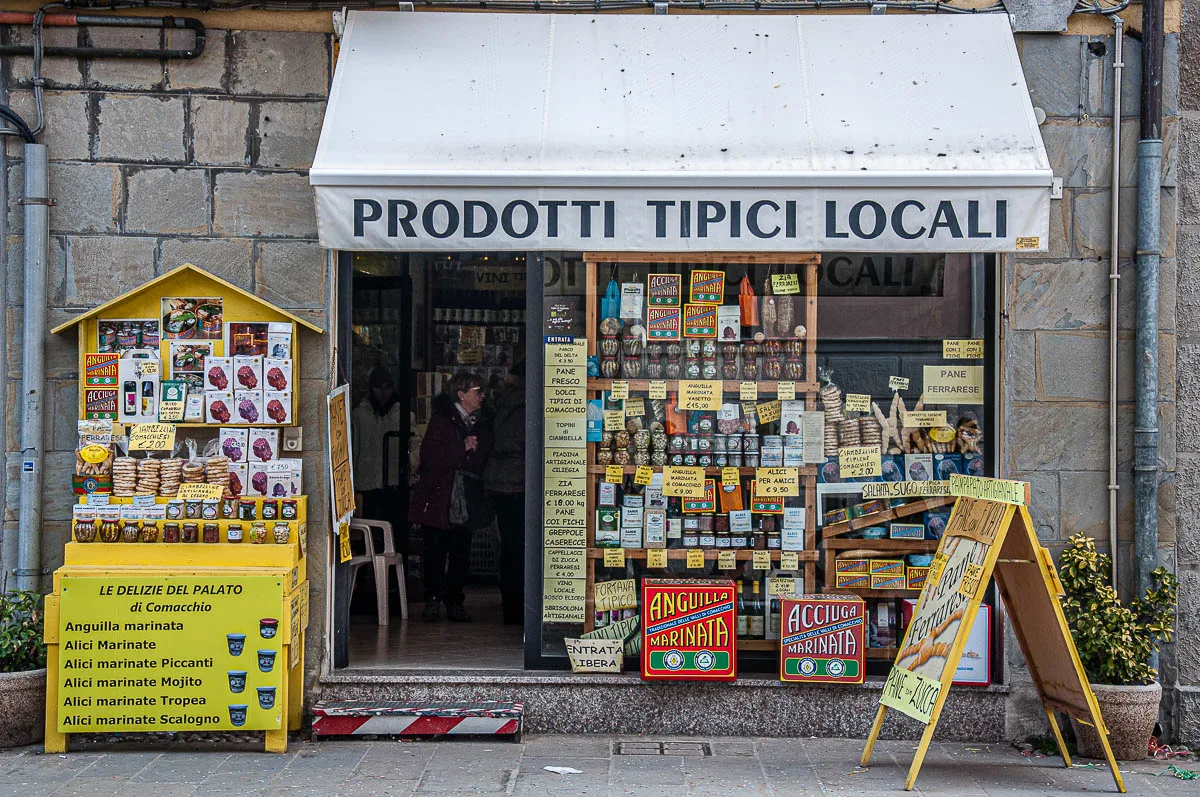
Comacchio is a great destination for foodies and people looking to experience Italy’s authentic local cuisines.
The town’s marinated eels are its most famous export. In fact, the Traditional Marinated Comacchio Valleys Eel is a Slow Food Presidium of the Slow Food Foundation. In other words, this is a traditional food product and food processing method at risk of extinction.
You will see the brightly coloured tins with marinated eels and anchovies all over the town. They make for a nice edible souvenir from your time in Comacchio.
In addition, the town is dotted with great restaurants serving freshly grilled eels and other seafood. Advanced booking around the Carnival period and on weekends is advised as local flocks to eat out and enjoy the fruits of their land and sea.
Eels are prepared in many different ways in Comacchio and, they say, there are 48 local eel recipes. Traditionally, eels are grilled and you can have a whole grilled eel served to you in a local restaurant. It has quite a unique fatty and heavy taste, very different from what you would expect from a fish.
In Comacchio, eels are also served as steak, used in risottos, and cooked in a soup called bec d’asan (donkey’s beak) which is served with slices of polenta. If you are interested, here is a link with some traditional for Comacchio eel-based recipes. All of them are in Italian, but you can get the gist with the help of Google Translate.
If you really love eels, then make sure that you head to Comacchio in October for its traditional Sagra dell’Anguilla (Eel Food Festival). This is when you can sample many different eel-based dishes and learn more about the fascinating history of Comacchio’s eels.
Apart from eels, Comacchio is also famous for the local marinated anchovies, fresh seafood, and several different local sweets. For example:
- topino d’ognissanti (mice of All Saints’ Day) – mouse-shaped biscuits. They are traditionally prepared only for All Saints’ Day and the Day of the Dead, celebrated in Italy respectively on the 1st and 2nd of November. The local legend says that the biscuits owe their shape to the mice that plagued Comacchio during the Napoleonic Era. The town was saved from the pesky rodents only after a long period of prayer to the Virgin Mary.
- anguilette dolci (small sweet eels) – eel-shaped biscuits celebrating Comacchio’s most famous food.
- focaccia alla zucca violina – soft focaccia filled with butternut squash.
What to Do Near Comacchio
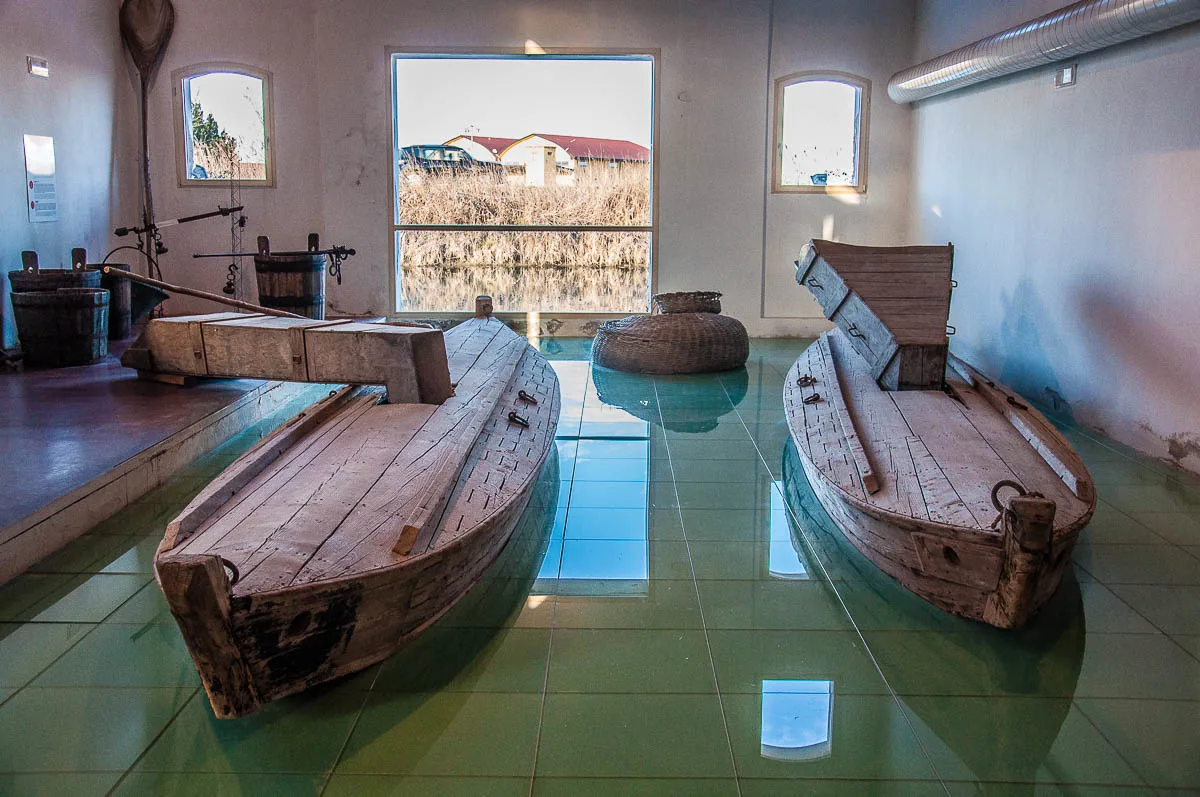
Next door to the Adriatic Sea and on the edge of its own lagoon, Comacchio is one of the major centres of the Delta of the River Po. In its vicinity, you will find many hidden corners to delight avid birdwatchers, passionate hikers, and lovers of nature.
Here are the most exciting places near Comacchio to see for yourself:
- Valli di Comacchio (Comacchio Valleys) – a series of brackish lagoons surrounded by wetlands. This is where the locals have been catching eels for centuries with the help of an ingenious system of connected basins called lavorieri. Stretching over 11,000 hectares, the Valleys are a birdwatcher’s paradise as over 300 species of birds like pink flamingoes, herons and kingfishers live here.
- Salina di Comacchio (Comacchio’s Saltworks) – much of Comacchio’s ancient history and prosperity were tightly connected to the abundance of salt in the wetlands that surround the town. Nowadays, you can visit the ancient Salina – a 600 hectares corner of the Valli di Comacchio. Here you can see one of Italy’s largest colony of pink flamingoes. You can tour the Salina on foot, by boat, by bike, and even by electric train. Click on the link for more information (in Italian) or head to Comacchio’s Museo Delta Antico for information about sightseeing tours and tickets.
- Lidi di Comacchio (Comacchio’s Lidos) – a few kilometres away from Comacchio you will find seven seaside resorts. They are a great destination in summer, especially if you want to avoid the busier resorts further down the Adriatic coast. Sandy beaches, great nightlife, family-friendly recreation, many different activities, and even several historic sights like the Pomposa Abbey and the port where Garibaldi and his wife Anita landed in 1849 make the Lidi di Comacchio a must-see when you are in this corner of Italy.
In Conclusion
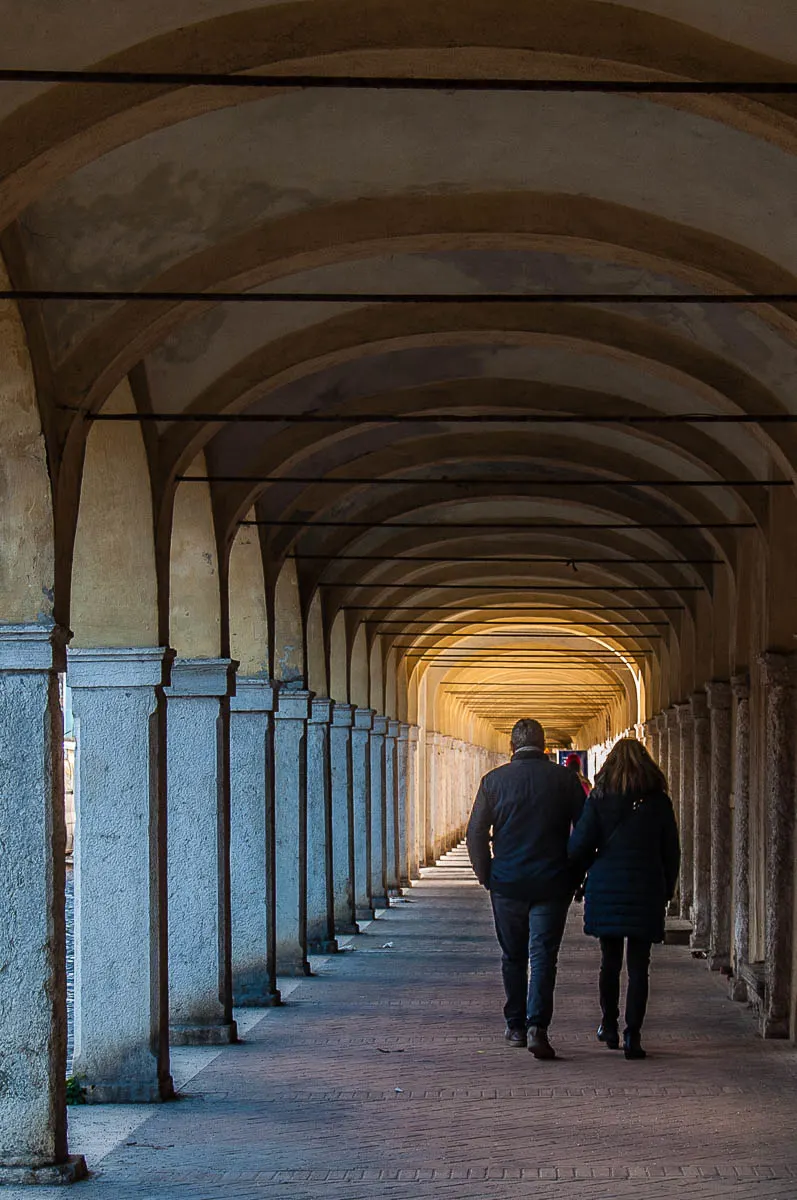
Comacchio is a pocket-size town in the Italian region of Emilia-Romagna. Famous for centuries for its marinated eels, nowadays Comacchio is a great destination for those seeking to escape the beaten track and to experience Italy authentically.
Set in the beautiful Delta of Po – the longest river in Italy – and a stone’s throw away from the Adriatic Sea, Comacchio has a lot to offer if you are interested in archaeology. An Etruscan town was discovered in its vicinity as well as a wrecked Roman merchant ship with its whole cargo. The town’s excellent Museo Delta Antico offers a first-row seat to their ancient histories.
Built on 13 islands and crisscrossed by canals, at a first glance you may expect Comacchio to be like a little Venice. The town has its own character though and its buildings – all pastel facades and red bricks – beautifully harmonise with the surrounding wetlands.
There is lots to see and do in Comacchio on a day trip from the nearby Ferrara, Ravenna, and Bologna. Especially, during the town’s annual Carnival when colourful boats take to the canals to parade and blast confetti at the thousands of spectators.
In the above blog post, I share with you five great things to do in Comacchio in addition to several other destinations you can explore in the immediate vicinity of the town.
I hope that this will inspire you to see Comacchio for yourself and to experience Italy from a new angle.
Enjoy your time in Comacchio, Italy!
More Helpful Links
- Bologna, Italy – 10 Stories to Introduce You to the Fat Lady of the Italian Cities
- Ravenna, Italy – 10 Stories to Make You Want to Visit the City of Mosaics Now
- 5 Most Beautiful Villages to Visit in Emilia-Romagna, Italy
- 18 of the Best Cities to Visit in Northern Italy (With Travel Tips and Nearest Airports)
- Day Trips from Padua, Italy – Over 35 Unmissable Destinations in Veneto, Lombardy, and Emilia-Romagna
Thank you for reading! Please, leave me a comment, pin the image below or use the buttons right at the top and at the end of this blog post to share it on social media.
For more useful information like this, please, like my blog’s page on Facebook and subscribe to my strictly no-spam newsletter.
